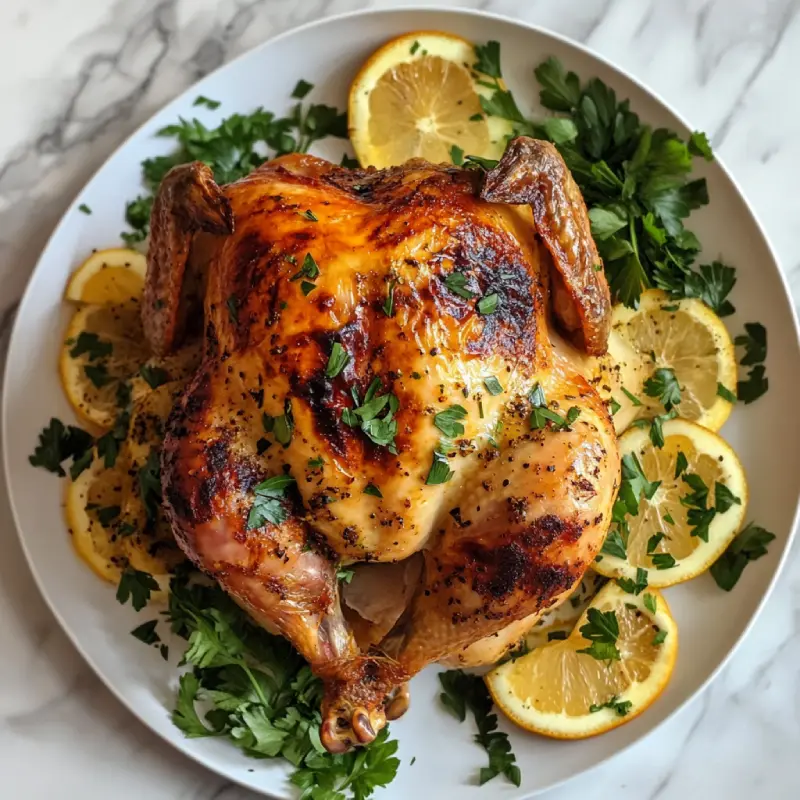Introduction
The carnivore diet is a dietary regimen that emphasizes the consumption of animal products, primarily focusing on meat, fish, and animal-derived foods while excluding plant-based foods entirely. This diet is rooted in the idea that a high-protein, low-carbohydrate intake can lead to various health benefits, including improved mental clarity, weight loss, and enhanced energy levels. Many adherents also report reduced inflammation and better digestion.
Cooking a whole chicken is particularly beneficial for those following the carnivore diet. Not only does it provide a rich source of protein and essential nutrients, but it also allows for versatility in meal preparation. A whole chicken can be roasted, grilled, or slow-cooked, making it an excellent centerpiece for family meals. Additionally, using the entire chicken minimizes waste and maximizes flavor, as the bones and skin contribute to a richer taste.
What is the Carnivore Diet?
The carnivore diet is a dietary approach that emphasizes the exclusive consumption of animal products, primarily meat, fish, and animal-derived foods, while eliminating all plant-based foods. This diet is based on the premise that humans thrive on animal proteins and fats, which provide essential nutrients necessary for optimal health.
Benefits of a Meat-Based Diet
- Simplicity: Following the carnivore diet is straightforward, as it involves minimal food choices, making meal planning and preparation easier.
- Potential Health Benefits: Many adherents report improvements in various health markers, including:
- Weight loss
- Enhanced mental clarity
- Increased energy levels
- Reduced inflammation and digestive issues
A whole chicken is a perfect fit for the carnivore lifestyle. It offers a complete source of nutrition and can be prepared in various ways, fitting seamlessly into the diet.
Why Choose Whole Chicken?
Whole chicken is an excellent choice for those on the carnivore diet due to its numerous benefits.
Nutritional Benefits of Chicken
- High in Protein: Chicken is an excellent source of high-quality protein, essential for muscle repair and overall bodily functions.
- Rich in Vitamins and Minerals: It provides essential nutrients, including:
- B Vitamins: Vital for energy production.
- Iron: Important for blood health.
- Zinc: Supports the immune system.
Economic Advantages
- Cost-Effective: Cooking a whole chicken is often more economical than purchasing individual cuts. It allows you to make multiple meals from one purchase, reducing overall food costs.
Versatility in Meal Preparation
- Various Cooking Methods: A whole chicken can be roasted, grilled, or slow-cooked, making it adaptable to different cuisines and meal types.
- Utilizing Leftovers: The leftover meat can be used in salads, soups, or sandwiches, maximizing the use of the entire bird.
Incorporating whole chicken into your diet not only enhances nutritional intake but also offers culinary flexibility, making it a staple for carnivore dieters.
Key Ingredients for the Recipe
To prepare a delicious carnivore whole chicken, it’s essential to use high-quality ingredients. Here’s a list of the key components you’ll need:
Essential Ingredients
- Whole Chicken:
The star of the dish, providing protein and essential nutrients. A weight of 3-4 pounds is ideal for even cooking. - Salt:
Essential for enhancing flavor and ensuring the chicken is well-seasoned. Consider using kosher salt for even distribution. - Spices:
Common spices include black pepper, garlic powder, and paprika, which add depth and flavor to the chicken.
Importance of Using High-Quality, Pasture-Raised Chicken
- Flavor: High-quality, pasture-raised chicken tends to be more flavorful due to the animal’s diet and living conditions.
- Nutritional Value: Pasture-raised chickens often have higher levels of omega-3 fatty acids and vitamins compared to conventionally raised chickens.
Suggestions for Optional Ingredients
- Herbs:
Fresh or dried herbs such as thyme, rosemary, or oregano can enhance the flavor profile. - Spices for Flavor:
Consider adding spices like cayenne pepper for heat or lemon zest for brightness.
Preparation Steps for Cooking a Whole Chicken
Follow these simple steps to prepare your whole chicken for cooking:
Step-by-Step Instructions
- Preheat the Oven:
Preheat your oven to 375°F (190°C). - Prepare the Chicken:
- Remove any giblets from the cavity of the chicken and pat it dry with paper towels. This helps achieve crispy skin.
- Season the cavity generously with salt and pepper.
- Season the Outside:
- Rub the entire outside of the chicken with olive oil or melted butter.
- Season with salt, pepper, and your choice of spices, making sure to cover all surfaces.
- Truss the Chicken (Optional):
Tie the legs together with kitchen twine for even cooking, although this step is optional.
Tips for Achieving the Best Texture and Flavor
- Resting Time: Allow the chicken to sit at room temperature for about 30 minutes before cooking to promote even cooking.
- Use a Meat Thermometer: Check the internal temperature; it should reach 165°F (74°C) in the thickest part of the thigh for perfect doneness.
By following these preparation steps, you’ll ensure a flavorful and juicy whole chicken that fits perfectly into your carnivore diet!
Cooking Methods for Whole Chicken
Cooking a whole chicken can be done in various ways, but roasting and grilling are two of the most popular methods. Each technique offers unique flavors and textures, ensuring a delicious meal.
Roasting
Roasting is a classic method that yields a beautifully cooked chicken with crispy skin and tender meat.
Step-by-Step Instructions for Roasting a Whole Chicken
- Preheat the Oven:
Set your oven to 375°F (190°C) to ensure even cooking. - Prepare the Chicken:
Season the chicken as detailed in the preparation steps. Consider adding lemon halves or garlic cloves inside the cavity for extra flavor. - Place in Roasting Pan:
Place the seasoned chicken breast-side up in a roasting pan. You can use a rack to elevate the chicken, allowing for even airflow. - Roast the Chicken:
Roast in the preheated oven for about 1.5 to 2 hours. A general rule is to cook the chicken for 20 minutes per pound. - Check Temperature:
Use a meat thermometer to check for doneness. The internal temperature should reach 165°F (74°C) in the thickest part of the thigh. - Rest the Chicken:
Allow the chicken to rest for about 10-15 minutes before carving. This helps retain moisture.
Tips for Achieving Crispy Skin and Juicy Meat
- Pat Dry: Ensure the skin is dry before seasoning and roasting to help achieve a crispy texture.
- Baste Occasionally: Basting the chicken with its juices or melted butter during cooking can enhance flavor and moisture.
Grilling
Grilling a whole chicken imparts a smoky flavor that is hard to beat, creating a delightful outdoor cooking experience.
Instructions for Grilling a Whole Chicken
- Prepare the Grill:
Preheat your grill to medium heat (about 350°F/175°C). If using charcoal, set up a two-zone fire (direct and indirect heat). - Season the Chicken:
Season the chicken as desired. A simple mixture of olive oil, salt, pepper, and your choice of spices works well. - Truss the Chicken:
Tie the legs together with kitchen twine to ensure even cooking and prevent burning. - Place on the Grill:
Place the chicken on the grill over indirect heat, breast-side up. Close the lid and grill for about 1.5 hours. - Check Doneness:
Use a meat thermometer to ensure the chicken reaches 165°F (74°C). If the skin is browning too quickly, move the chicken to indirect heat.
Suggestions for Marinades and Seasoning Techniques
- Marinade Ideas:
Try a marinade of olive oil, lemon juice, garlic, and fresh herbs for a flavorful kick. Marinate for at least 2 hours or overnight for the best results. - Dry Rubs:
Use a dry rub with spices like paprika, garlic powder, and herbs for added flavor without the mess of marinades.
Grilling adds a delightful smoky flavor to your whole chicken, making it a fantastic choice for summer cookouts and gatherings!
Serving Suggestions for Whole Chicken
Once your whole chicken is cooked to perfection, it’s time to serve it up in style! Here are some ideas for slicing and plating, as well as recommended sides that complement the carnivore diet.
Ideas for Serving the Whole Chicken
- Slicing:
Carefully carve the chicken using a sharp knife. Start by removing the legs and thighs, then slice the breast meat into even pieces. Present the pieces on a large platter for an attractive display. - Plating:
Arrange the sliced chicken on a serving platter. Garnish with fresh herbs, like rosemary or thyme, to enhance the presentation and add a pop of color.
Recommended Sides That Fit the Carnivore Diet
- Bone Broth:
Serve a warm cup of homemade bone broth as a nutritious side. It pairs perfectly with chicken and adds extra collagen and flavor. - Animal Fat:
Drizzle some rendered animal fat, like beef tallow or duck fat, over the chicken for added richness. This not only enhances flavor but also aligns with the principles of the carnivore diet.
These serving suggestions will make your whole chicken meal not only delicious but also visually appealing!
Variations and Customizations for Whole Chicken
Exploring different cooking techniques and flavors can elevate your whole chicken experience. Here are some alternative recipes and creative ways to use leftover chicken:
Alternative Recipes Using Different Cooking Techniques or Flavors
- Spicy Grilled Chicken:
Marinate the chicken in a mix of hot sauce, olive oil, and cayenne pepper for a spicy kick. Grill over medium heat for a smoky flavor. - Herb-Roasted Chicken:
Coat the chicken with a blend of fresh herbs such as thyme, rosemary, and parsley mixed with butter. Roast until golden brown for a fragrant and flavorful dish. - Slow-Cooked Chicken:
Place the chicken in a slow cooker with a few cups of bone broth and spices. Cook on low for 6-8 hours for tender, fall-off-the-bone meat.
Suggestions for Using Leftover Chicken in Carnivore-Friendly Meals
- Chicken Bone Broth:
Use the carcass to make a rich bone broth. Simply simmer it with water, herbs, and spices for several hours to extract maximum flavor and nutrients. - Chicken Salad:
Shred leftover chicken and mix it with mayonnaise, mustard, and spices for a quick and satisfying chicken salad. - Egg and Chicken Scramble:
Sauté shredded chicken with eggs and cheese for a hearty breakfast or brunch option.
By utilizing these variations and clever ways to use leftovers, you can enjoy the benefits of whole chicken in multiple delicious forms!
FAQs About Carnivore Whole Chicken Recipe
Here are some common questions related to the carnivore whole chicken recipe:
- Can I cook a whole chicken in an air fryer?
Yes, cooking a whole chicken in an air fryer is possible. Set the air fryer to 360°F (180°C) and cook for about 1 hour, or until the internal temperature reaches 165°F (74°C). - What is the best way to season a whole chicken?
Simple seasonings like salt, pepper, and your choice of spices or herbs work well. For a carnivore-friendly approach, stick to salt and pepper or add garlic powder for extra flavor. - How long should I let the chicken rest after cooking?
Allow the chicken to rest for 10-15 minutes before carving. This helps the juices redistribute for a more flavorful and juicy result. - Can I use the skin in a carnivore diet?
Yes, the skin is a source of healthy fats and is encouraged in the carnivore diet, enhancing both flavor and texture.
Conclusion
In conclusion, cooking a whole chicken is a simple and rewarding experience, especially on a carnivore diet. It provides numerous health benefits, including high protein and essential nutrients while being cost-effective and versatile. We encourage you to try this recipe and explore the vast array of carnivore-friendly meals that can fit into your diet. Enjoy the delicious flavors and the simplicity of whole chicken cooking!

